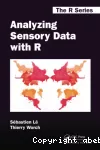Adresse
Infodoc : Réseau des bibliothèques et centres de documentation d'AgroParisTechFrance
contact

Détail de l'auteur
Auteur Lê, Sébastien |
Documents disponibles écrits par cet auteur (2)
 Ajouter le résultat dans votre panier Faire une suggestion Affiner la recherche Interroger des sources externes
Ajouter le résultat dans votre panier Faire une suggestion Affiner la recherche Interroger des sources externes
 Livre15 EUR
Livre15 EUR978-2-7535-0938-21 vol. (VIII-224 p.)
1 vol. (VIII-224 p.)Prix : 15 EUR ISBN : 978-2-7535-0938-2 
 Livre
Livre978-1-4665-6572-21 vol. (XVII-356 p.)
1 vol. (XVII-356 p.)ISBN : 978-1-4665-6572-2




